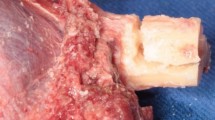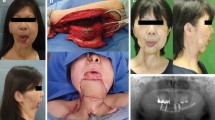Abstract
Introduction
Successful outcome of any vascularised free flap basically depends upon the successful restoration of circulation in the flap after anastomosis. As the flap ischemic time is the significant factor which determines the outcome of any free flaps, due consideration is given to reduce the time for anastomosis for reperfusion. The present study compares and evaluates whether the usage of microvascular couplers with the conventional suturing reduce the ischemic time of the free flaps.
Materials and Methods
Thirty patients were randomly divided into two groups (each group consisting of 15 patients) for mandibular reconstruction using free fibular microvascular flap. In group 1, microanastomosis was done with conventional suturing whereas microvascular couplers were used in group 2. Intraoperatively, patency, leakage and tissue perfusion were assessed. The time taken for anastomosis (time taken for suturing and applying couplers) and flap ischemic time (from the time of flap division from the donor site till the flap is reperfused after anastomosis) were calculated for both the groups.
Results
Significant decrease in time for anastomosis was observed in group 2, which resulted in decrease in flap ischemic time and in overall operating time.






Similar content being viewed by others
References
Ragnarsson R, Berggren A, Klintenberg C (1990) Microvascular anastomoses in irradiated vessels: a comparison between the Unilink system and sutures. Plast Reconstr Surg 85:412
Jeremic G, Shrime M, Irish JC (2006) The microvascular anastomotic device and its role in free tissue transfer. UTMJ 8:51
Morritt N, Raine C, McLean NR (2002) The double-barrelled end-to-end microvascular anastomosis. Br J Plast Surg 55:64
Ross DA, Chow JY, Shin J, Restifo R, Joe JK, Sasaki CT, Ariyan S (2005) Arterial coupling for microvascular free tissue transfer in head and neck reconstruction. Arch Otolaryngol Head Neck Surg 131:891
Douglas AR, Ariyan S, Restifo R (2003) Use of the operating microscope and loupes for head and neck free microvascular tissue transfer. Arch Otolaryngol Head Neck Surg 5:129
Author information
Authors and Affiliations
Corresponding author
Rights and permissions
About this article
Cite this article
Murugan, S., John, R.R., Krihnakumar Raja, V.B. et al. A Comparative Study on Microvascular Anastomosis of Vascularised Free Fibular Flap with Couplers and Suturing in Mandibular Reconstruction. J. Maxillofac. Oral Surg. 15, 363–366 (2016). https://doi.org/10.1007/s12663-015-0855-5
Received:
Accepted:
Published:
Issue Date:
DOI: https://doi.org/10.1007/s12663-015-0855-5




